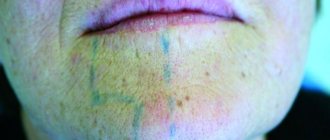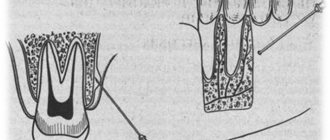Features and principle of action of conduction anesthesia
Conduction anesthesia is a local anesthesia and involves the introduction of a drug into the peripheral region of the nerve that ensures the functioning of this part of the body. Dentists in most cases use conduction anesthesia to treat teeth located in the lower jaw.
The technique is aimed at blocking impulses transmitted from nerves to the brain. As soon as the drug enters the nerve, sensitivity is reduced to a minimum level. The duration of action of the anesthetic depends on the substance used.
A number of features of conduction anesthesia can be distinguished:
- The injection is carried out with drugs, the concentration of which reaches 2%. Compared to other methods of pain relief, the content of active substances is at a high level.
- Loss of sensitivity does not occur at the site of drug administration, but in the nerve that is located in this area of the body.
- Conduction anesthesia has a minimal number of complications and side effects.
- The method allows you to control the duration of pain relief and the area of effect of the drug.
Complications of tuberal anesthesia
It should be borne in mind that during tubercular conduction anesthesia, the posterior superior alveolar artery (a branch of the internal maxillary artery) or the infraorbital artery may be injured. To prevent this complication, it is necessary, as already indicated, to stay directly at the bone if possible and not to immerse the needle more than 2.5 cm. The best way to avoid injury to blood vessels during any conduction anesthesia, and these vessels in particular, is continuous release anesthetic solution throughout the entire time the needle is advanced deep into the tissue towards the target point of anesthesia.
Bleeding from the injection site is easily stopped by pressing on the bleeding area with a sterile napkin.
With tuberous conduction anesthesia, as with other peripheral conduction anesthesia discussed below, an area of facial skin blanching may appear already at the beginning of the injection.
This phenomenon is usually associated with spasm of a vessel located in the area of anesthetic injection as a result of the slightest damage to its wall with an injection needle and even just the touch of the needle to the vessel. For the significance of this phenomenon, see the section “Anesthesia at the greater palatine foramen.”
Pallor of facial skin naturally occurs as a result of injury to the vessel and the entry into it of an anesthetic solution containing adrenaline, as well as as a result of washing the vessel with such a solution.
Indications for conduction anesthesia
- Implantation.
- Carrying out surgical intervention (removal of cysts, granulomas, ulcers and benign neoplasms).
- Therapy of dental diseases.
- Preparation before surgery.
- Removal of teeth or roots.
- Inflammation in the oral cavity.
- Carrying out preventive procedures to prevent periodontal diseases and caries.
- Inability to use general anesthesia.
Contraindications to conduction anesthesia
- Poor blood clotting. This feature can lead to bleeding.
- Allergy to used painkillers.
- Disorders of the cardiovascular system (arrhythmia, ischemia, tachycardia, heart valve defects, etc.). These pathologies are not compatible with adrenaline, which can be used to constrict blood vessels.
- The presence of inflammation or ulcers at the injection sites of the anesthetic drug.
- Open wounds, infectious inflammations and contaminated wound surfaces on the patient’s extremities.
- Childhood.
- Mental disorders, unstable psycho-emotional background of the patient.
- Patient refusal to use this type of anesthesia.
Methods of administering conduction anesthesia
Methods of administering conduction anesthesia can be divided into 2 groups:
- Extraoral. Used in the presence of inflammatory foci in the oral cavity. These include:
- Submandibular. The pain medication blocks the inferior alveolar nerve.
- Podzykulova. The drug is injected under the edge of the cheekbone arch.
- Mandibular. The mandibular foramen loses sensitivity.
Once the anesthetic is injected into the treated area, the numbing effect occurs within 15 minutes. The duration of the anesthetic effect depends on the type of medication used.
- Intraoral. These include:
- Apodactylous. The alveolar nerve is blocked.
- Torusal. The anesthetic is injected into the mandibular ridge. Molars and premolars lose sensitivity.
- Tuberal. Anesthesia is injected into the area of the molars located on the upper jaw.
- Infraorbital. It is used to block sensitivity in the anterior wall of the maxillary bone, mucous membrane and alveolar process.
- Palatine. The palate and alveolar process are anesthetized.
- Incisive. The anesthetic is injected between the upper canine and incisor. The hard palate, nasopalatine nerve and soft tissues surrounding the tooth become numb.
When administered intraorally, the effect occurs 10 minutes after injection.
Preparation for conduction anesthesia
Before performing the operation under general anesthesia, it is necessary to undergo a standard examination. During diagnosis, special attention should be paid to the patient’s neurological condition, his psyche and behavior.
Before the procedure, the specialist will explain in simple, accessible words about the sequence and method of administering anesthesia, as well as the sensations that may accompany the patient during pain relief. In addition, the doctor will definitely check the patient’s reaction to the anesthetic drug to make sure there is no allergic reaction.
The anesthesiologist must follow the rules when administering conduction anesthesia:
- First of all, it is necessary to numb the skin using a gentle method.
- The needle must be fixed in a strictly defined place in order for the anesthetic to reach the desired area.
- Paresthesia must be present. It indicates that pain relief was carried out correctly and sensitivity has decreased.
- Drugs should be administered in portions with aspiration samples to prevent them from entering the bloodstream.
- During anesthesia, it is necessary to continuously monitor the patient's blood pressure and pulse.
- The room in which the procedure is performed must be equipped with all the necessary instruments for pain relief, as well as means of resuscitation and treatment of possible complications.
Stages of administration of conduction anesthesia
- A consultative appointment, during which a specialist determines the presence of chronic diseases and evaluates test results that may become contraindications to pain relief.
- Detection of nerve endings that need to be anesthetized.
- Disinfection of the skin puncture area with a special solution.
- Injection of anesthetic into certain areas. At the same time, the rate of administration of the anesthetic is observed and the volume of the injected substance is controlled.
- Monitoring the patient after pain relief.
- Before the start of surgery, the patient is asked control questions to determine the level of sensitivity.
The duration of the analgesic effect depends on the drug used and its dosage. Modern painkillers retain their effect for up to 40-60 minutes.
Extraoral anesthesia
Having made a puncture with a needle in the area of the lower anterior corner of the cheek bone, the needle is then directed upward at an angle of 45° and again towards the tubercle of the upper jaw, bringing it to the bone. And then the anesthetic solution is deposited. The anesthetic effect occurs in approximately the same time as with the intraoral method of anesthesia.
However, during the process of anesthesia, a hematoma appears on the tubercle of the upper jaw, which is a consequence of injury to the veins of the pterygopalatine plexus by the needle.
Computed tomography studies of the path of solution propagation during tuberal anesthesia confirmed that such complications are most likely.
This tomogram, which was taken 5 days after intraoral anesthesia, shows that there are contours of a hematoma on the tubercle of the upper jaw in the pterygopalatine fossa. Approximately 40-60% is allocated to the fact that this cellular formation will fester and turn into phlegmon.
When using the tuberal method of anesthesia, injury to the veins of the pterygopalatine plexus is almost impossible to avoid, and there is also a fairly high risk of complications, in particular if the intraoral method is used. All this threatens the health and even the life of the patient. That is why it is recommended to use this type of anesthesia extremely rarely.
Drugs used
The success of conduction anesthesia depends not only on the technique used, but also on the drugs used. The following medications are used for this pain relief technique:
- Solutions of the Articaine series. They have a long lifespan and high efficiency. These include:
- Ultracaine.
- Septanest.
- Ubistezin.
- Lidocaine. It is a highly effective anesthetic and at the same time contains a minimal amount of toxic substances.
- Melivacaine. The duration of action of this drug is about 40 minutes. Melivacaine has no contraindications for use.
- Novocaine. This is perhaps the most frequently used remedy. It is characterized by low toxicity and rapid hydrolysis in the body.
Location of the posterior superior alveolar foramina (target point of tuberal anesthesia)
To determine the target point, it is necessary, as mentioned above, to navigate using some easily accessible identification points. In this case, the upper teeth and the socket edge of the upper jaw are used.
The distance from the buccal wall of the socket of the upper wisdom tooth to the posterior superior socket openings is 2-2.5 cm.
We examined 75 skulls and upper jaws of adults and found the following distances from the buccal wall of the wisdom tooth socket to the posterior superior socket foramina: in 44 cases - 2 cm, in 23 - slightly less than 2.5 cm, in 8 - slightly more than 1.5 cm. Tuberculosis technique (tuberal) conduction anesthesia (injection site and needle direction) Intraoral method of tuberal anesthesia
When the patient's mouth is half-closed, the cheek is moved away with a mouth mirror, a spatula or a blunt hook. (Tightly closed jaws cause significant tension in the adjacent muscles, which prevents proper anesthesia from this route.) Then the zygomaticoalveolar ridge, crista zygomaticoalveolans, is felt, and behind it, above the second molar (closer to the third), slightly below the transitional fold (the place where the mucous membrane of the gums enters the mucous membrane of the cheek), a needle with a diameter of 0.75-0.8 mm is inserted and 4.5-5 cm long. At the same time, direct the syringe as far as the cheek allows, transversely to the bone, turning it so that the needle goes upward, backward and inward, all the time close to the bone. When encountering an obstacle, make slight turns. Thus, holding the bone, advance the needle 2 cm from the injection site and inject 1.5-2 ml of anesthetic solution there, after which they wait 10-12 minutes for the onset of complete anesthesia.
Advantages and disadvantages of conduction anesthesia
Advantages:
- The drug can be administered outside the surgical site.
- Anesthesia has a long-lasting effect. A specialist can monitor the duration of action of the medication.
- To achieve the desired effect, small doses of painkillers are sufficient.
- There is no deformation of soft tissues in the operated area.
- When exposed to conduction anesthesia, salivary activity decreases.
- The technique is safe, so it can be used from the age of 12, and also in some cases in pregnant and lactating women.
- The cost of the procedure is affordable.
Flaws:
- In order for anesthesia to pass without complications, the specialist must have certain skills and sufficient experience.
- There is a high probability of the anesthetic entering a blood vessel.
- Restricted use by age (only from 12 years old).
- Risk of injury to nerves or blood vessels.
Anesthesia of the mandibular nerve
If it is necessary to numb the lower jaw, anesthetic drugs are injected into the mandibular nerve, which should numb the tongue, lips and gums. As a rule, the patient feels the effect after a quarter of an hour, the duration of “anesthesia” is up to three hours. Such anesthesia is performed only on one half of the jaw.
Indications for conduction anesthesia in dentistry are:
- Inflammatory processes of the oral cavity and soft facial structures;
- Extraction of tooth roots and crowns;
- Extraction of incorrectly erupted teeth;
- Impossibility of intravenous anesthesia during operations on the dentoalveolar region.
Conduction anesthesia is contraindicated for:
- Emotional instability of the patient;
- Infection of the oral cavity and facial tissues;
- Allergic reactions to anesthetics;
- Previous interventions that have changed the anatomy of the face, which makes it difficult to find the corresponding nerve trunk;
- Under 12 years of age;
- Lack of adequate contact - for example, the patient is deaf and dumb.
- An absolute contraindication is infection in the puncture area, which is fraught with serious septic complications.
In dentistry, special ampoules (carpules) with a precise dose of sterile anesthetic and epinephrine are used for conduction anesthesia. The carpula is equipped with an extremely thin needle, so the anesthesia procedure is practically painless and well tolerated by patients.
Options for conduction anesthesia in dental practice:
- Central - the mandibular or maxillary nerves are blocked;
- Peripheral - more often during manipulations on the upper jaw.
- The drug for anesthesia of the lower jaw can be administered from the mucous membrane or from the outside (in case of inflammatory processes). With submandibular anesthesia, the anesthetic is injected at the base of the jaw to the inferior alveolar nerve trunk. By injecting the anesthetic a little deeper, the lingual nerve is blocked.
The subzygomatic route involves inserting a needle under the zygomatic arch, moving downwards by 3-3.5 cm. With mandibular anesthesia, all the teeth of one half of the jaw, as well as the mucous membrane of the sublingual area, lips, and chin are desensitized at once. The patient feels anesthesia after 15 minutes.
To anesthetize the upper jaw, tuberal anesthesia is performed (in the area of the 2nd upper tooth), anesthetizing both the teeth and the maxillary sinus. An infraorbital blockade is indicated if it is necessary to anesthetize the anterior part of the jaw (the drug is administered near the roots of the incisors). Palatal anesthesia eliminates the sensitivity of all teeth from the canine to the last on this half of the jaw.
Possible complications
In the practice of specialists at the World of Dentistry clinic, severe complications after conduction anesthesia occur in extremely rare cases. Negative effects include neuropathy and an inadequate response of the body to the administered drug. Complications that are normal and go away on their own include:
- Muscle weakness.
- Goosebumps effect.
- Partial loss of sensitivity.
The above symptoms disappear without a trace a maximum of a month after the procedure. Damaged nerves are completely restored.










